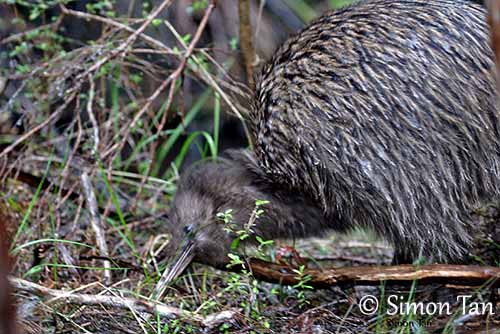
Text by Nicole Bouglouan
Photographer:
Simon Tan
PBase Bird galleries
Illustrator:
John Gerrard Keulemans (1842-1912)
North Island Brown kiwi - Kiwi de Mantell
Keulemans, John Gerrard, 1842-1912 : Apteryx Mantelli [North Island kiwi] London, 1873. Buller, Walter Lawry (Sir) 1838-1906 : A history of the birds of New Zealand. 1st ed. London, 1873. Ref: PUBL-0134-358. Alexander Turnbull Library, Wellington, New Zealand. http://natlib.govt.nz/records/23031923
Great Spotted Kiwi adult female - Kiwi roa femelle adulte
Keulemans, John Gerrard, 1842-1912 : Apteryx haastii. Potts. [female]. / J. G. Keulemans delt. T. Walter, lith. 1/2 [size]. [1876]. Rowley, George Dawson :Ornithological miscellany. London, Trubner & Co, 1876. Ref: PUBL-0035-1-004. Alexander Turnbull Library, Wellington, New Zealand. http://natlib.govt.nz/records/23105108
Great Spotted Kiwi - Kiwi roa
Keulemans, John Gerrard, 1842-1912: Apteryx haastii.
Right: Adult [male]; Left: juvenile, female. Shows an adult male great spotted kiwi viewed from the side, with a juvenile female, both in an open landscape.
Little Spotted Kiwi - Kiwi d'Owen
Keulemans, John Gerrard, 1842-1912 - Buller's "A History of the Birds of New Zealand, 1st edition. Published 1873.
Sources:
HANDBOOK OF THE BIRDS OF THE WORLD vol 1 by Josep del Hoyo-Andrew Elliot-Jordi Sargatal - Lynx Edicions - ISBN: 8487334105
KNOW YOUR NEW ZEALAND BIRDS by Lynnette Moon - New Holland Publishers – ISBN: 1869660897
L’ENCYCLOPEDIE MONDIALE DES OISEAUX - Dr Christopher M. Perrins - BORDAS - ISBN: 2040185607
BirdLife International (BirdLife International)
New Zealand bird status between 2008 and 2012
Wikipedia, the free encyclopaedia
Te Ara – The Encyclopedia of New Zealand
New Zealand birds and birding (Narena Olliver)
APTERYGIDAE FAMILY
New Zealand Kiwis
The New Zealand kiwis are endemic to this country and the oldest bird family of these islands. They were formerly placed in the order Struthioniformes, along with the Emu and the cassowaries, but today, these stunning birds have their own order, the Apterygiformes.
Five species are recognised, all more or less threatened. The Southern Brown Kiwi (Apteryx australis) is relatively common but remains vulnerable to several threats.
Like numerous island species, the kiwis have suffered from habitat destruction with massive deforestation, first by the Maoris and then, by the Europeans. The replacement of the native vegetation by exotic plantations and farmland are still going on at present. This is a major threat for these birds.
Population decline was caused by introduced mammalian predators such as stoats, weasels, rats, cats and dogs. Kiwis are not able to elude this type of predators. In addition, the trapping of the Common brush-tailed Possum (Trichosurus Vulpecula) with poisoned baits was another major cause of mortality. These traps are now regulated.
And finally, hunting, capture or killing of kiwis by humans for food and feathers were a heavy pressure until these birds were declared “absolutely protected birds” in 1921. But some local extinction had already occurred.
Currently, captive breeding programmes, protection of the habitat and creation of reserves for the establishment of new populations are under way.
The kiwi is the national emblem of New Zealand.

A.a. lawry
The kiwis have round, pear-shaped body with small head and long, strong neck. The lower body, including pelvis, legs and feet is very robust. The legs’ muscles are powerful and the feet are well developed with four toes, three in front and a smaller hind toe. There is a strong claw at the end of each toe.
The reduced wings are about 4-5 centimetres long. There is a claw at the end, hidden in the thick plumage. They do not have tail feathers.
The long bill is slightly downcurved and flexible, with the nostrils situated towards the tip, giving these birds a good sense of smell. The colour may vary from ivory to pink or brownish. The bill of the Southern Brown Kiwi is 20 centimetres long, and in all species, females have longer bill than males. When they adopt a standing position, the kiwis use bill and legs as a tripod, while the bill’s tip remains on the ground. We can see some rictal bristles which have a tactile function at the base of the bill. The tongue is hard, horny and pointed. They have a fairly limited vision due to their small eyes, but the earholes are large, allowing the bird to hear the larger preys moving on the ground.
The bristly, hair-like, shaggy plumage is made of peculiar feathers with wide, soft base and hard, hair-like, waterproof distal end. Males and females have similar appearance but females are larger and heavier than males. The juveniles usually have softer plumage than adults.
They have mainly brown to grey-brown plumage with darker streaks or scaled pattern with paler feather edges.
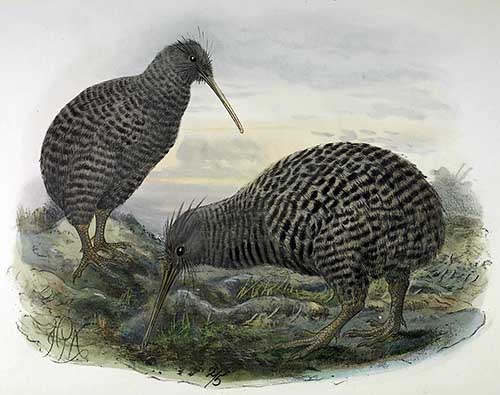
The Little Spotted Kiwi (Apteryx owenii) is the smallest with a length of 30 centimetres and a weight of 1150 grams for the male and 1650 grams for the female. It has mostly greyish-buff plumage with slight yellowish tinge and irregular brownish bands. The bill is straighter, legs and feet are pale, almost whitish like the claws. This species occurs on several islands in the Cook Strait.
The Great Spotted Kiwi (Apteryx haastii) is greyer with chestnut tinge on back. The pattern appears more regular with larger black spots and thinner pale bands. It is about 45 centimetres in length and its weight is 2,2 kg (M) and 3 kg (F). It is found in the more mountainous areas of northern Nelson, the NW Coast and the Southern Alps. Some birds are living in island reserves.
The Southern Brown Kiwi (Apteryx australis) has a length of 45 centimetres and a weight of 2,4 kg(M) – 3 kg (F). It has dark reddish-brown plumage with black streaks. It lives on South Island (Fiordland and Westland) and Stewart Island (race lawryi).
The North Island Brown Kiwi (Apteryx mantelli) was formerly a subspecies of A. australis. It has dark brown plumage with reddish-brown and black streaks. It is about 40 centimetres and its weight is 2 kg (M) and 2,7 kg (F). It is found throughout North Island.
The Okarito Kiwi (Apteryx rowi) is about 40 centimetres in length and its weight is 1,9 kg (M) and 2,6 kg (F). It has brown plumage overall, with pale brown feathers streaked with brown and black. This species was formerly a subspecies of A. mantelli, and was accepted as full species in 2003. It occurs in a small area of the Okarito forest on the West Coast of the South Island.
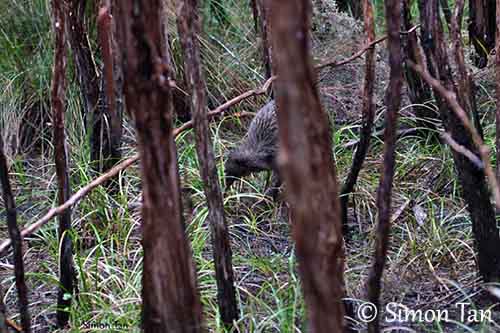
The kiwis’ preferred habitat is the rain forest, formerly found throughout New Zealand. But the deforestation has led to the destruction of the original habitat and these birds occupy now other types of areas such as shrubland, scrub, grassland’s edges, and subtropical and temperate forests. However, they may frequent commercial pine plantations.
They need warm climate and humidity and a good soil texture to dig their burrows and find preys. They occur from sea-level in coastal areas, up to 1200 metres of elevation in alpine regions.
They are mostly nocturnal, and spend much time in their burrow during the day. But the Southern Brown Kiwi, subspecies “Apteryx australis lawryi » from Stewart Island can be seen foraging by day. The other races become active at sunset. They move about among the dense vegetation on the forest floor, and remain very secretive.
When searching for food at night, they often cover considerable distances, up to three kilometres in one night through the vegetation. They are good swimmers and are able to cross streams or pools.
They are omnivorous and feed primarily on invertebrates such as earthworms, beetles (adult and larvae), moth and fly larvae, large crickets and spiders found above and in the soil. They also consume fruit, seeds and leaves but to a lesser extent. Actually, their diet varies according to seasons and food availability.
Preys are detected thanks to the sense of smell and the sensitive bill. The kiwi moves slowly on the ground and probes the soil with its long bill. It is also suggested that these birds can hear the larger invertebrates while they are moving. The prey is caught with the tip of the bill in the earth, while the bird moves the head back and forwards, but slowly and carefully in order to avoid breaking the victim.
Females need to accumulate subcutaneous fat before the laying of the large eggs and males for the long incubation period. In addition, the food is scarce during a long period in summer.
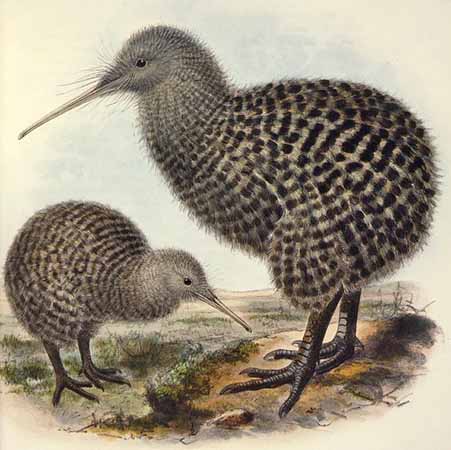
They usually live in pairs and remain in the same territory all their lives. They are territorial all year round, but mainly during the breeding season. They call and chase all intruders. Fight may occur occasionally, involving jumping and kicking and much noise. These birds are strongly attached to their territories.
Neighbour males perform vocal duels, sometimes leading to aggressive encounters on the borders. During the fights, snorting and bill-snapping can be heard. When they are threatened, the kiwis produce growls, hisses and snap their mandibles. Duets between mates are common. Mating and copulation are accompanied by high-pitched “purr”.
Like in numerous species, the calls increase during the breeding season. They begin soon after dusk with a maximum during the first 1-3 hours, and can be heard less frequently throughout the night. Males call more than females, and female’s calls differ in tone and tempo.
Little Spotted Kiwi (Apteryx owenii) - SOUNDS BY XENO-CANTO
Great Spotted Kiwi (Apteryx haastii - SOUNDS BY XENO-CANTO
The kiwis are monogamous with long-term pair-bonds. From some observations, the courtship displays include chases, jumps, hissing and a “close-contact grunting”. In both Brown Kiwi species, during the pre-copulation displays, the male calls and the female answers and then, mates chase each other round in circles. The Little Spotted Kiwis perform “bill-to-bill display” during which the mates are facing each other with crossed bills pointed downwards. They produce soft grunts for several minutes.
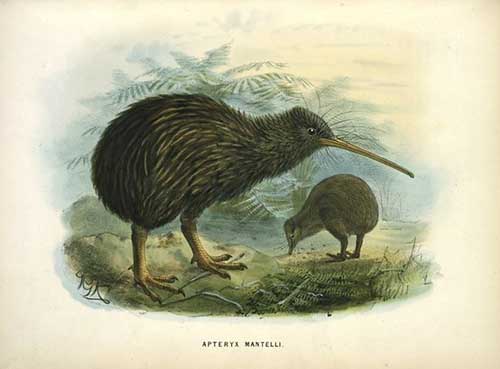
The breeding season starts in spring and the laying occurs between August and October. The kiwis make the nest in burrows excavated in steep banks, but they also use natural cavities, hollows in tree stumps or rock crevices. Usually, the burrow is excavated months or even years before being occupied. During this period, the vegetation is growing around the entrance which becomes well concealed.
About two weeks before the laying, the male brings nest materials such as moss, lichens and grass into the nesting chamber.
The eggs are very large comparing the size of the female. They are four times the normal size for a bird of their proportions. The eggs of the Southern Brown Kiwi are about 14/20% of the female’s body, whereas in the Little Spotted Kiwi, they constitute up to 25% of the female’s body. Before the laying, the female walks about with her legs apart. She lays one or two eggs with a long interval of 25-30 days in the Southern Brown Kiwi, and 2-3 weeks in the Little Spotted Kiwi. Replacement clutches are produced following nest-failure. The birds may sometimes rear two broods in a single season.
Usually, the male incubates, except in the Great Spotted Kiwi where male and female share the incubation. In the race A.a. lawryi from Stewart Island, the female may help sometimes, like in the Okarito Kiwi.
After the laying of the second egg, the female leaves the burrow and remains in the vicinity of the nest-site, often in a nearby burrow. She returns to her nest once the chicks have hatched and helps the male for the brooding. The incubation is very long and lasts between 63 and 92 days according to the species, but kiwis have low body temperature of 38°C, rather similar to that of a mammal than of a bird.
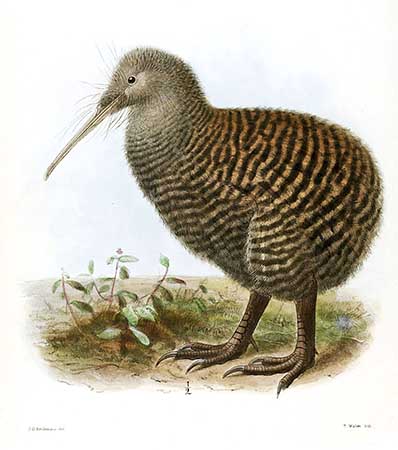
Great Spotted Kiwi
Adult female
At hatching, the chicks break the shell with their feet because they lack the egg tooth. Their body is entirely covered in feathers and they resemble adults. They are precocial and can walk after 5-6 days. They leave the nest at night and are able to feed themselves, loosely guarded by parents, and often return after the adults. They are independent about 14-20 days after hatching. They remain in the territory for some time, but they roost apart from their parents. However, the Southern Brown Kiwis may accompany their juveniles during sometimes 1-3 years.
When the male leaves the burrow during the incubation, it often covers the entrance with some vegetation, but the Weka is able to find the eggs and to eat them. In the same way, when the young kiwis leave the burrow, they are very vulnerable to predation by stoats, cats and dogs.
The Southern Brown Kiwi is listed as Vulnerable due to restricted range and population decline with 19,900 individuals.
The North Island Brown Kiwi is classified as Endangered, with a population of about 25,000 individuals and declining.
The Little Spotted Kiwi is listed as Near Threatened. This species is confined to some offshore, predator-free, small islands where the populations are stable. The global population is estimated at 1,200 individuals with about 800 mature birds.
The Great Spotted Kiwi is listed as Vulnerable due to rapid decline with a population estimated at 5,300/5,400 mature individuals.
The Okarito Kiwi is classified as Endangered. Its population is estimated at 200/249 mature individuals. The increase is due to captive rearing to avoid predation by introduced stoats.
Today, the kiwi is strictly protected by laws and has become the national emblem of New Zealand. There are numerous conservation measures under way with predator-free areas, captive breeding, translocation of birds to reserves and general protection of both birds and habitat.
Kiwis are strange and stunning birds with ancient origins. They were living in an environment free of predators and humans. Both are responsible of their decline. Maybe next day, humans will win the battle against the dangers which still threaten these birds with history…
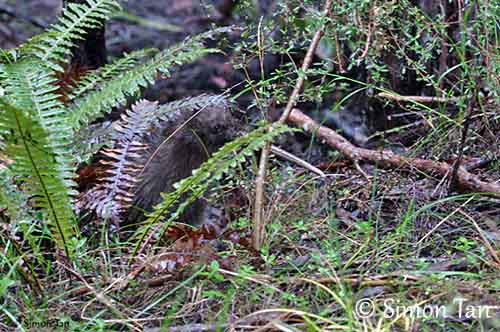
Foraging among the thick vegetation. The long bill is visible.